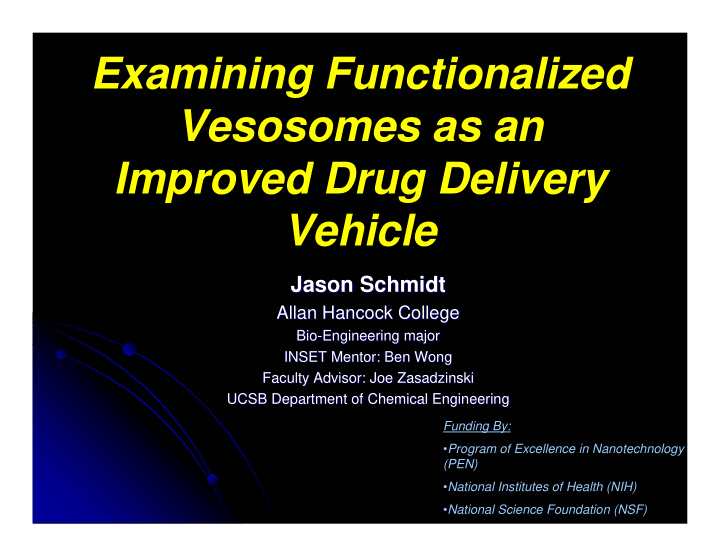



Examining Functionalized Vesosomes as an Improved Drug Delivery Vehicle Jason Schmidt Jason Schmidt Allan Hancock College Allan Hancock College Bio- -Engineering major Engineering major Bio INSET Mentor: Ben Wong INSET Mentor: Ben Wong Faculty Advisor: Joe Zasadzinski Faculty Advisor: Joe Zasadzinski UCSB Department of Chemical Engineering UCSB Department of Chemical Engineering Funding By: • Program of Excellence in Nanotechnology (PEN) • National Institutes of Health (NIH) • National Science Foundation (NSF)
What Is A Vesosome? What Is A Vesosome? Vesicle , Vesosome , diameter ~ 50 nm diameter ~ 1um Zasadzinski Group � A vesicle is a tiny phospholipid bi-layer “bubble” � A vesosome is a comparably larger vesicle that encapsulates many smaller vesicles
The Potential to Greatly Increase the The Potential to Greatly Increase the Efficiency of Drug Therapies Efficiency of Drug Therapies � Increase in drug retention in vivo � Reduction in amount of drug(s) necessary for therapy � Reduction of side effects / damage to healthy tissues � Multi-compartment structure may allow loading of drug “cocktails” � Potential for drug targeting, further reducing side-effects � Increase in time-release control � Enhanced resistance to immune Zasadzinski Group system
Summer Research Goals Summer Research Goals Begin In Vivo Experimentation & Analysis Dilution Filtration Injection
Vesosome Production Vesosome Production Formation of Vesicles Formation of Sheets Sheets Interdigitation “Onions” Vesicles Vesicles Add Wash Freeze/ EtOH Thaw Heating Purification
Vesosomes In Buffer Vesosomes In Buffer Confocal Microscope Confocal Microscope Confocal Microscope Green Channel Red Channel Red+Green Channels
Vesosomes In Buffer Vesosomes In Buffer Successful Encapsulation Unlikely Encapsulation TEM Image TEM Image Cryo Transmission Electron Microscope Images
Vesosomes In Vivo Vesosomes In Vivo Confocal Microscope Confocal Microscope Red Channel Intensity Image Red Channel Intensity Image, Inverted Vesosomes Aggregations
Average Circulation Time Average Circulation Time of Vesosomes In Vivo of Vesosomes In Vivo 160 Avg # of Vesosomes Observed 5 140 4.5 Adjusted Vesosomal 4 120 Fluorescence (a.u.) 3.5 100 Avg #<1um 3 80 Avg #>1um 2.5 Total Avg # 2 60 1.5 40 1 20 0.5 0 0 0.05 0.5 3 5 24 0 5 10 15 20 25 Time From Start (Hrs) Time From Start (Hrs) Results: •Overall half-life ~ 2hrs, which is shorter than expected •Significant difference in half-life of single vs. aggregate vesosomes •Vesosomes are aggregating in vivo
Continuing Work Continuing Work 3 4 2 5 1 6 Zasadzinski Group • Continuing In Vivo Experiments • Refine Functionalization; Control Aggregation • Quantification of Functionalization • Encapsulation of Multiple Different Internal Components • Incorporation of Channel Proteins Into External Bi-layer
Acknowledgements Acknowledgements Internships in Nanosystems, Science, Engineering, and Technology (INSET) The Joseph Zasadzinski Molecular Engineering Group Ben Wong, Siggie Steltenkamp, Prajna Dhar, Ian Shieh, Patrick Seelheim, Patrick Stenger, Htet Khant The Erkki Ruoslahti Group David Peters
Recommend
More recommend